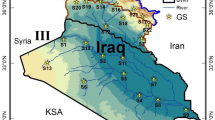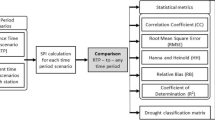Abstract
Drought affects the natural features, economic conditions, and living beings. Climate change impacts numerous factors linked to drought on a global scale. A temperature rise contributes to a decline in precipitation, evaporation, and transpiration; hydrologic and agricultural dryness results from increased temperature. In deciding the energy flux between the atmosphere and the earth's surface, land surface temperature (LST) is a critical environmental factor. The assessment of the temporal variations of surface temperature and monitoring of drought uses Normalized Difference Vegetation Index (NDVI). The raster calculator in ArcGIS software performs the calculation using the different equations to obtain the vegetation index, land surface emissivity (LSE), brightness temperature, and surface temperature. Integrating the tools in ArcGIS software, the authors created a model for the automatic retrieval of surface temperature. The model results provided the land surface temperature for different years from 2016 to 2020. The minimum and maximum LST derived from the model was ranging from 14.54 to 49.90°C (2016–2020). The minimum and maximum NDVI derived from the model was ranging from -0.97 to 0.99 (2016–2020). The in situ surface temperature and Landsat-derived surface temperature had a 92 % of correlation. There was a nearly 99 % of correlation between NDVI and LST during 2016–2020. Due to the temperature rise and insufficient rainfall, there was stress in crops, and the region experienced a drought situation.























Similar content being viewed by others
Data availability
The Landsat satellite data and SRTM DEM required for the research work was obtained from the USGS Earth Explorer website https://earthexplorer.usgs.gov/. The rainfall and temperature data were collected from the State Ground and Surface Water Resources Data Centre, Water Resource Department, Tharamani, Chennai – 600113 and also from State Level Water Testing Laboratory, Tamilnadu Water Supply and Drainage Board, Chepauk, Chennai – 600005. Geology, geomorphology, and soil maps were obtained from National Bureau of Soil Survey & Land Use Planning (NBSS & LUP), Bangalore.
Code availability
Not applicable
References
Andualem TG, Belay G, Guadie A (2018) Land Use Change Detection Using Remote Sensing Technology. J Earth Sci Clim Change 9(10):496
Avdan U, Jovanovska G (2016) Algorithm for Automated Mapping of Land Surface Temperature Using LANDSAT 8 Satellite Data. J Sensors 2016:1480307
Barsi JA, Lee K, Kvaran G, Markham BL, Pedelty JA (2014) The Spectral Response of the Landsat-8 Operational Land Imager. Remote Sens 6(10):10232–10251
Belal A-AA, El-Ramady HR, Mohamed ES, Saleh AM (2014) Drought Risk Assessment Using Remote Sensing and GIS Techniques. Arab J Geosci 7(1):35–53
Das AC, Noguchi R, Ahamed T (2021) An Assessment of Drought Stress in Tea Estates Using Optical and Thermal Remote Sensing. Remote Sens 13(14):2730
Esther Metilda J, Annadurai R, Kamalanandhini M (2020) Identification of Soil Moisture for Drought Assessment - A Case Study in Chengalpattu District, Tamilnadu, India. Int J Adv Sci Technol 29(4s):699–704
Falahatkar S, Hosseini SM, Soffianian AR (2011) The Relationship between Land Cover Changes and Spatial-Temporal Dynamics of Land Surface Temperature. Indian J Sci Technol 4(2):76–81
Ghaleb F, Mario M, Sandra AN (2015) Regional Landsat-Based Drought Monitoring from 1982 to 2014. Climate 3(3):563–577
Guo J, Ren H, Zheng Y, Lu S, Dong J (2020) Evaluation of Land Surface Temperature Retrieval from Landsat 8/TIRS Images before and after Stray Light Correction Using the SURFRAD Dataset. Remote Sens 12(6):1023
Hassan MM, Smith AC, Walker K, Rahman MK, Southworth J (2018) Rohingya Refugee Crisis and Forest Cover Change in Teknaf, Bangladesh. Remote Sens 10(5):689
Kamalanandhini M, Annadurai R (2021a) Assessment of Drought Condition Based on Standardized Precipitation Index and Soil Moisture Condition-A Case Study in Parts of Chengalpattu District, Tamilnadu, India. J Green Eng 11(1):262–273
Kamalanandhini M, Annadurai R (2021b) Assessment of Five Meteorological Indices for Monitoring the Drought Condition in Chengalpattu District, Tamilnadu, India. Mater Today: Proc 46(9):3699–3703
Kamalanandhini M, Kalaivizhi R, Percy VPG, Srividhya S, Dheepak S, Thiyaneshwaran K (2019) Effect of Flood Event on Water Quality. Rasayan J Chem 12(2):849–854
Kamalanandhini M, Annadurai R, Dheepak S, Deepak P, Esther Metilda J (2021) Assessment of Hydrological Drought Condition and Its Impact on Water Quality-a Case Study in Parts of Chengalpattu District, Tamil Nadu, India. Rasayan J Chem 14(1):51–57
Kumari B, Tayyab M, Ahmed IA, Baig MRI, Khan MF, Rahman A (2020) Longitudinal Study of Land Surface Temperature (LST) Using Mono- and Split-Window Algorithms and Its Relationship with NDVI and NDBI over Selected Metro Cities of India. Arab J Geosci 13(1040):1–19
Lanning M, Wang L, Scanlon TM, Vadeboncoeur MA, Adams MB, Epstein HE, Druckenbrod D (2019) Intensified Vegetation Water Use under Acid Deposition. Sci Adv 5(7):eaav5168
Lejeune Q, Davin EL, Guillod BP, Seneviratne SI (2015) Influence of Amazonian Deforestation on the Future Evolution of Regional Surface Fluxes, Circulation, Surface Temperature and Precipitation. Clim Dyn 44(9–10):2769–2786
Li ZL, Tang BH, Wu H, Ren H, Yan G, Wan Z, Trigo IF, Sobrino JA (2013) Satellite-Derived Land Surface Temperature: Current Status and Perspectives. Remote Sens Environ 131:14–37
Muthumanickam D, Kannan P, Kumaraperumal R, Natarajan S, Sivasamy R, Poongodi C (2011) Drought Assessment and Monitoring through Remote Sensing and GIS in Western Tracts of Tamil Nadu, India. Int J Remote Sens 32(18):5157–5176
Nivedha Deve S, Jasmineniketha M, Geetha P, Soman KP (2017) Agricultural drought analysis for Thuraiyur Taluk of Tiruchirappali District using NDVI and land surface temperature data. 11th International Conference on Intelligent Systems and Control (ISCO)
Orhan O, Ekercin S, Dadaser-Celik F (2014) Use of Landsat Land Surface Temperature and Vegetation Indices for Monitoring Drought in the Salt Lake Basin Area, Turkey. Sci World J 2014:142939
Pervez S, McNally A, Arsenault K, Budde M, Rowland J (2021) Vegetation Monitoring Optimization With Normalized Difference Vegetation Index and Evapotranspiration Using Remote Sensing Measurements and Land Surface Models Over East Africa. Front Clim 3:589981 0: 1
Peters AJ, Rundquist DC, Wilhite DA (1991) Satellite Detection of the Geographic Core of the 1988 Nebraska Drought. Agric For Meteorol 57(1–3):35–47
Sarker MDLR, Janet N, Mansor SA, Ahmad BB, Shahid S, Chung E-S, Reid JS, Siswanto E (2020) An Integrated Method for Identifying Present Status and Risk of Drought in Bangladesh. Remote Sens 12(17):2686
Shashikant V, Shariff ARM, Wayayok A, Kamal MR, Lee YP, Takeuchi W (2021) Utilizing TVDI and NDWI to Classify Severity of Agricultural Drought in Chuping, Malaysia. Agronomy 11(6):1243
Sobrino JA, Raissouni N (2000) Toward Remote Sensing Methods for Land Cover Dynamic Monitoring: Application to Morocco. Int J Remote Sens 21(2):353–366
Sobrino JA, Jiménez-Muñoz JC, Paolini L (2004) Land Surface Temperature Retrieval from LANDSAT TM 5. Remote Sens Environ 90(4):434–440
Sun D, Kafatos M (2007) Note on the NDVI-LST Relationship and the Use of Temperature-Related Drought Indices over North America. Geophys Res Lett 34(24):1–4
USGS (2020) Landsat 8 Collection 1 (C1) Land Surface reflectance code (LaSRC) product guide, LSDS-1368, Version 3.0. In: Sayler K, U.S.G.S. (eds) EROS Sioux Fall, SD. Retrieved from: https://prd-wret.s3.us-west-2.amazonaws.com/assets/palladium/production/atoms/files/LSDS-1368_L8_C1-LandSurfaceReflectanceCode-LASRC_ProductGuide-v3.pdf. Accessed 5 Aug 2020
Vogt JV, Niemeyer S, Somma F, Beaudin I, Viau AA (2000) Drought monitoring from space. In: Vogt JV, Somma F (eds) Drought and drought mitigation in Europe. Advances in Natural and Technological Hazards Research, vol 14. Springer, Dordrecht. https://doi.org/10.1007/978-94-015-9472-1_13
Wang F, Qin Z, Song C, Lili T, Karnieli A, Zhao S (2015) An Improved Mono-Window Algorithm for Land Surface Temperature Retrieval from Landsat 8 Thermal Infrared Sensor Data. Remote Sens 7(4):4268–4289
Wang L, Lu Y, Yao Y (2019) Comparison of Three Algorithms for the Retrieval of Land Surface Temperature from Landsat 8 Images. Sensors 19(22):L5049
Wardlow BD, Anderson MC, Verdin JP (2012) Remote Sensing of Drought : Innovative Monitoring Approaches. CRC Press, Boca Raton
Xie F, Fan H (2021) Deriving Drought Indices from MODIS Vegetation Indices (NDVI/EVI) and Land Surface Temperature (LST): Is Data Reconstruction Necessary? Int J Appl Earth Obs Geoinf 101:102352
Acknowledgements
The authors acknowledge the support from State Ground and Surface Water Resources Data Centre, Tharamani, Tamil Nadu, India, and USGS Earth Explorer for providing the necessary data for carrying out this research work.
Author information
Authors and Affiliations
Corresponding author
Ethics declarations
Conflict of interest
The author declares no competing interests.
Additional information
Responsible Editor: Venkatramanan Senapathi
This article is part of the Topical Collection on Recent advanced techniques in water resources management
Rights and permissions
About this article
Cite this article
Mohan, K., Ramasamy, A. & Varghese, J. Drought severity assessment using automated land surface temperature retrieval technique. Arab J Geosci 14, 2358 (2021). https://doi.org/10.1007/s12517-021-08672-1
Received:
Accepted:
Published:
DOI: https://doi.org/10.1007/s12517-021-08672-1




